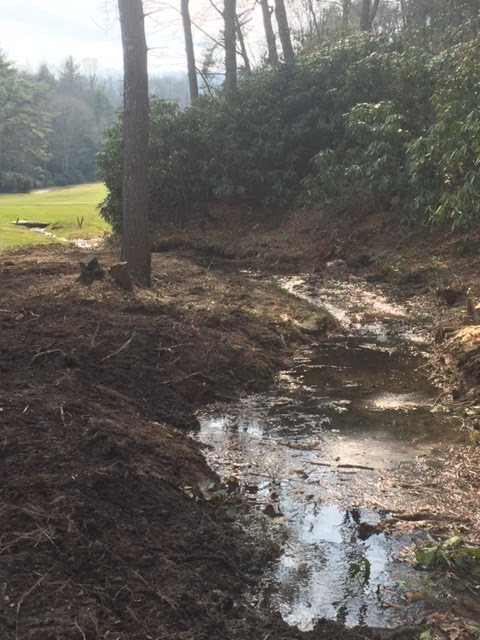On the 10th hole, we are draining the swamp (as Trump says) on the left side of the hole and pushing the rough closer to the rhododendron. This is a great project that most of you will really appreciate!
Here is your Turf Twister of the week: These two photos (above and below) show the intermediate rough cut on #10. We are resodding the rough on this hole this winter to give a better defined look since the rough is contaminated with Creeping Bentgrass. I know the fairway has crept out over the years, closer to the creek than intended. Above, you can see the white line I painted on the fairway- left-center of the photo. Note the dark green grass right of the line and lighter-yellow turf left of the white line. I immediately declared that this white line is where the rough line/fairway line will meet, hence, the white line I painted. Your trivia question is, how would I known this? The answer is at the bottom of this post.
Hint: Think back on the history of this fairway and what is different about it compared to the others...
Scroll to the bottom for the answer in BLUE font.
Below, Rhododendron were thinned to expose more of the creek on #11. It is a beautiful portion of the creek as well, adjacent the ladies tee.
Answer from the question above:
In 1999, the fairway on #10, which used to stay extremely wet, was cored out- native soil removed, drainage installed, followed by an 8" sand cap. This line delineates where the sand capping stops; meaning that is the original edge of the fairway. Sand holds on to less water and nutrients compared to native clay soils. The nutrient holding capacity of the clay soils allows the turf to maintain a deeper green color. The turf growing on sand, requires more fertilizer inputs because leaching occurs. Furthermore, the native soil with less air porosity resists temperature changes compared to sand. More air space in the soil means better roots and better drainage but more temperature fluctuations. These 2 things lead to the turf being a slightly different color.





